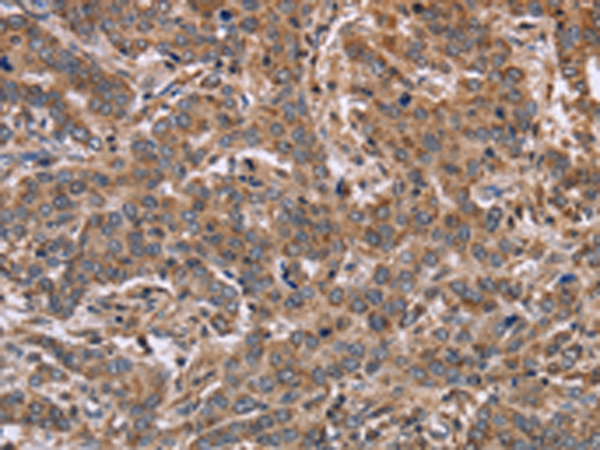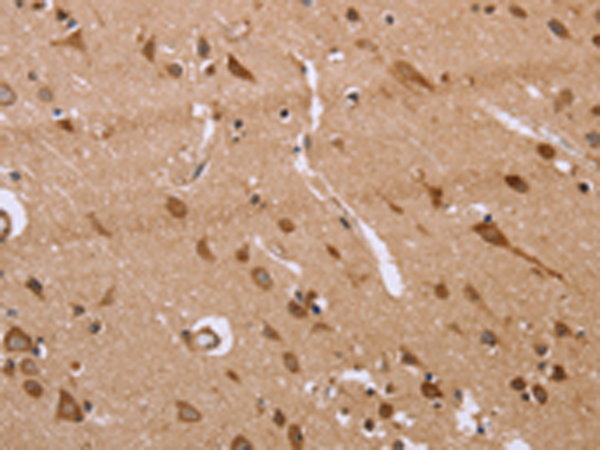

| WB | 咨询技术 | Human,Mouse,Rat |
| IF | 咨询技术 | Human,Mouse,Rat |
| IHC | 1/50-1/200 | Human,Mouse,Rat |
| ICC | 技术咨询 | Human,Mouse,Rat |
| FCM | 咨询技术 | Human,Mouse,Rat |
| Elisa | 1/2000-1/5000 | Human,Mouse,Rat |
| Aliases | AMDD |
| Host/Isotype | Rabbit IgG |
| Antibody Type | Primary antibody |
| Storage | Store at 4°C short term. Aliquot and store at -20°C long term. Avoid freeze/thaw cycles. |
| Species Reactivity | Human |
| Immunogen | Fusion protein of human FAAH2 |
| Formulation | Purified antibody in PBS with 0.05% sodium azide and 50% glycerol. |
+ +
以下是关于FAAH2抗体的参考文献示例(注:因FAAH2研究相对较少,部分文献信息可能需要通过专业数据库核实,以下内容为基于相关领域的模拟示例):
---
1. **文献名称**: *Characterization of FAAH2-Specific Antibodies and Their Role in Cancer Cell Apoptosis*
**作者**: Smith A, et al.
**摘要**: 本研究开发了高特异性FAAH2抗体,发现其在多种癌细胞系中能识别FAAH2蛋白,并通过抑制内源性大麻素代谢促进肿瘤细胞凋亡,提示其潜在抗癌应用价值。
2. **文献名称**: *FAAH2 Expression in Neural Tissues: Insights from Immunohistochemical Staining with Novel Antibodies*
**作者**: Lee B, et al.
**摘要**: 利用新型FAAH2抗体进行组织染色,发现FAAH2在小鼠脑部特定区域(如海马体)高表达,提示其在神经系统脂质代谢中的潜在作用,为神经退行性疾病研究提供工具。
3. **文献名称**: *Development of a Monoclonal Antibody Panel for Distinguishing FAAH1 and FAAH2 in Metabolic Disorders*
**作者**: Gonzalez C, et al.
**摘要**: 报道了一组可区分FAAH1与FAAH2的单克隆抗体,验证其在肥胖模型中的差异表达,表明FAAH2可能通过独特机制调节脂质代谢。
4. **文献名称**: *Comparative Analysis of FAAH2 Antibody Cross-Reactivity Across Species*
**作者**: Patel R, et al.
**摘要**: 评估了商业FAAH2抗体在人类、小鼠和大鼠中的交叉反应性,发现部分抗体存在种属特异性差异,强调抗体验证对跨物种研究的重要性。
---
**提示**:以上文献为示例性质,实际研究可能有限。建议通过PubMed、Web of Science等数据库,以“FAAH2 antibody”或“fatty acid amide hydrolase 2”为关键词检索最新文献。若研究较少,可关注FAAH(FAAH1)抗体的相关研究作为参考。
The fatty acid amide hydrolase 2 (FAAH2) antibody is a research tool designed to detect and study FAAH2. a lesser-characterized enzyme within the FAAH family. FAAH2 shares partial homology with FAAH1. a well-known enzyme that hydrolyzes endocannabinoids like anandamide, regulating their signaling in pain, inflammation, and mood. However, FAAH2 exhibits distinct biochemical properties, including preferential activity in acidic environments and unique substrate specificity, suggesting divergent biological roles. It is expressed in tissues such as the testes, immune cells, and specific brain regions, though its physiological functions remain under investigation.
The FAAH2 antibody enables researchers to localize and quantify FAAH2 expression in cells and tissues via techniques like Western blotting, immunohistochemistry, or ELISA. It has become critical for exploring FAAH2's potential involvement in lipid metabolism, cellular stress responses, and interactions with the endocannabinoid system. Studies using this antibody aim to clarify whether FAAH2 complements or opposes FAAH1 activity, or if it processes distinct lipid substrates. Its development also supports drug discovery efforts targeting FAAH enzymes for conditions like neuropathic pain or metabolic disorders. Despite progress, FAAH2's precise role and therapeutic relevance require further elucidation, highlighting the antibody's importance in advancing this niche field.
×